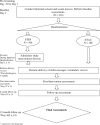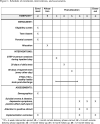Skills to Enhance Positivity in adolescents at risk for suicide: Protocol for a randomized controlled trial
- PMID: 37862324
- PMCID: PMC10588868
- DOI: 10.1371/journal.pone.0287285
Skills to Enhance Positivity in adolescents at risk for suicide: Protocol for a randomized controlled trial
Abstract
Background: Suicide and suicidal behavior during adolescence have been steadily increasing over the past two decades. The preponderance of interventions focuses on crisis intervention, underlying psychiatric disorders, regulating negative affect, and reducing cognitive distortions. However, low positive affectivity may be a mechanism that contributes to adolescent suicidal ideation and behaviors independent of other risk factors. Skills to Enhance Positivity (STEP) is an acceptance-based intervention, designed to increase attention to, and awareness of, positive affect and positive experiences. Results from a pilot RCT demonstrated engagement of the target (positive affect) and a decrease in clinical outcomes (suicidal events; i.e., either a suicide attempt or an emergency intervention for an acute suicidal crisis), providing support to test the clinical effectiveness of STEP in a larger clinical trial with clinical staff implementing the intervention.
Objective: To test the effectiveness of STEP, compared to Enhanced Treatment as Usual (ETAU), in reducing suicidal events and ideation in adolescents admitted to inpatient psychiatric care due to suicide risk. We hypothesize that those randomized to STEP, compared to ETAU, will have lower rates of suicide events, active suicidal ideation (SI), and depressed mood over the 6-month follow-up period. We hypothesize that those randomized to STEP, compared to ETAU, will demonstrate greater improvement in the hypothesized mechanisms of attention to positive affect stimuli and gratitude and satisfaction with life.
Methods: Participants will be randomized to either STEP or ETAU. STEP consists of four in-person sessions focused on psychoeducation regarding positive and negative affect, mindfulness meditation, gratitude, and savoring. Mood monitoring prompts and skill reminders will be sent via text messaging daily for the first month post-discharge and every other day for the following two months. The ETAU condition will receive text-delivered reminders to use a safety plan provided at discharge from the hospital and healthy habits messages, matched in frequency to the STEP group. This trial was registered on 6 August 2021 (ClinicalTrials.gov NCT04994873).
Results: The STEP protocol was approved by the National Institute of Mental Health (NIMH) Data and Safety Monitoring Board on March 4, 2022. The RCT is currently in progress.
Discussion: The STEP protocol is an innovative, adjunctive treatment that has the potential to have positive effects on adolescent suicidal ideation and attempts beyond that found for standard treatment alone.
Copyright: © 2023 Yen et al. This is an open access article distributed under the terms of the Creative Commons Attribution License, which permits unrestricted use, distribution, and reproduction in any medium, provided the original author and source are credited.
Conflict of interest statement
The authors have declared that no competing interests exist.
Figures


References
-
- Hedegaard H, Curtin SC, Warner M. Suicide mortality in the United States, 1999–2017. US Department of Health and Human Services, Centers for Disease Control and Prevention. National Center for Health Statistics Data Brief. 2018;330.
-
- Centers for Disease Control and Prevention, National Center for Health Statistics. National Vital Statistics System, Mortality 1999–2020 on CDC WONDER Online Database, released in 2021. Data are from the Multiple Cause of Death Files, 1999–2020, as compiled from data provided by the 57 vital statistics jurisdictions through the Vital Statistics Cooperative Program. Accessed at http://wonder.cdc.gov/ucd-icd10.html on Apr 17, 2023 7:16:55 PM [Internet].
Publication types
MeSH terms
Associated data
Grants and funding
LinkOut - more resources
Full Text Sources
Medical
Miscellaneous

